Welcome to FISH FOOD TIMES
Jun. 2018 issue No.174

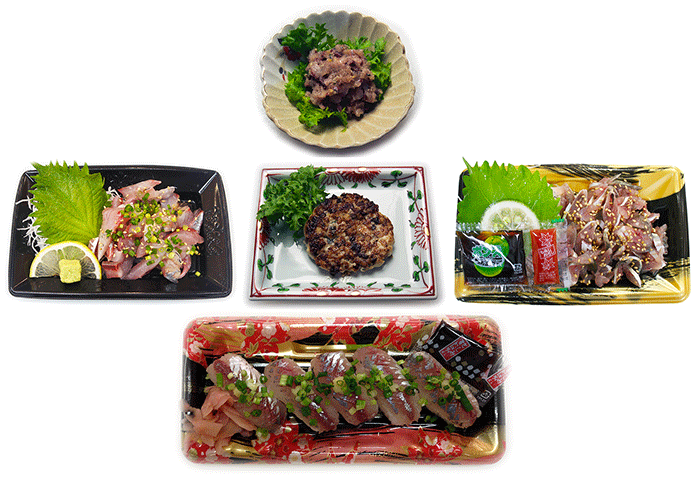
Variety of Japanese horse mackerel
Too much known edible cheap fish for the masses
Recently, the author asked me "Why will not you pick up a horse mackerel at FISH FOOD TIMES?" At that time I answered appropriately that "I do not know why, because I did not have the opportunity."
However, looking back on that later, I did not have that opportunity. The real reason is because I had a question about how to make an article about horse mackerel which is a general cheap fish for the masses Japanese people ordinarily eaten from ancient times.
I did not mention anything about the relatives of horse mackere so far, but in No. 94 Zengo segoshi sashimi (October, Heisei 23) I mentioned about horse mackerel of bean size, �� 69 Giant trevally hiratsukuri sashimi (September 2009 issue), he picked up Giant trevally belonging to Carangidae family, genus Caranx. Although not ignoring the horse mackerel, when it became the japanese horse mackerel which is the representative of the horse mackerel, it was generally too well known that it had an impression that it was difficult to handle in reverse.
However, FISH FOOD TIMES, which was 15 years since its launch, thought that it would be impossible to avoid referring to Japanese horse mackerel, which could be said to be the mainstay of the mainstay as a fish to eat. The problem is how to treat japanese horse mackerel. Considering what Japanese horse mackerel tells "fish sales pro" assumed as a reader of FISH FOOD TIMES, it is not even possible to write particularly interesting things that are hardly known to the world, so the content of the description I want to make a point of view as "Japanese horse mackerel selling hint".
Difference between japanese horse mackerel and japanese scad

The upper image is a japanese horse mackerel for explanation. Japanese horse mackerel is slightly different in appearance between the shallow type that settles in the shallow sea reef area and the migration type that travels around the open sea. The shallow type is generally yellowish strongly, abundant and rounded, the migrant type is dark as a whole and muscular and slender. japanese horse mackerel is an English name horse mackerel, scientific name is Trachurus japonicus, both English name and scientific name are given Japanese name.
What is very similar to japanese horse mackerel is Japanese scad of the bottom image, English name is japanese scad, scientific name Decapterus maruadsi.

The difference between japanese horse mackerel and japanese scad is that unlike Japanese horse mackerel, which is also called a flat horse mackerel, if japanese scad is frequently dealt with, japanese scad has aliases like round horse mackerel, I can understand in a moment with the feeling of the scalp which is more difficult to remove than the japanese horse mackerel. Even more obvious physical differences exist in the japanese scad, although there are small upper and lower fins called 'syoriki' in the rounded enclosure of the japanese scad image below but not in japanese horse mackerel.

�@ 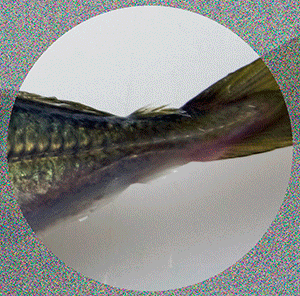
Japanese scad lives in the relatively southern sea area more than japanese horse mackerel, the autumn to winter is the most frequent catch, the Japanese horse mackerel, the spring to summer season, is getting out of time. In general, evaluation on the market is higher for Japanese horse mackerel, but this is because Japanese horse mackerel is easier to remove leather than japanese scad, as for japanese horse mackerel It seems to be an evaluation that the fat content including subcutaneous fat is many and tasty.
In addition, I will introduce Amberstripe scad which inhabits in the southern ocean, as a horse mackerel whose fat content is lower than chiai meat of fish and which stands out more than japanese scad. The image below is taken by the writer at a fish market on an island in the Nansei Islands, but the Amberstripe scad just caught on the island is eaten even with sashimi like japanese horse mackerel, it only becomes an open processed product such as kusaya I want you to know that it is not.
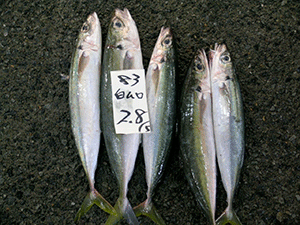 �@�@�@
�@�@�@
| Mackerel scad | Roughear scad |
|---|
Japanese horse mackere fishing ground and catchment area
By the way, returning to japanese horse mackere, japanese horse mackere was caught more mainly from the East China Sea to the Japan Sea side than the Pacific side, and half of Japan's annual catch was landing in Nagasaki prefecture and Shimane prefecture.�@ �@�@�@�@
| Ministry of Agriculture statistics Heisei 28 | ||
|---|---|---|
| japanese horse mackere | ||
| 1st | Nagasaki prefecture | 55,100t |
| 2nd | Shimane prefecture | 24,200t |
| 3rd | Miyazaki prefecture | 11,000t |
| japanese scad | ||
| 1st | Miyazaki prefecture | 8,500t |
| 2nd | Kagoshima prefecture | 4,600t |
| 3rd | Wakayama prefecture | 3,200t |
| Total relatives of horse mackerel | 155,200t | |
Among them, the Matsuura fish market in Matsuura City, Nagasaki Prefecture, which is the base of the Japanese oceanic tropical net (Maki Ami) fishery, is the fish market boasting the largest catch in Japan, including horse mackerel as well as mackerel. It is a major supply base for horse mackerels in Japan, and dry food businesses throughout the country seem to be receiving supplies such as horse mackerel as a commodity material from this fish market in many places.
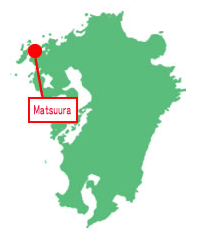 �@
�@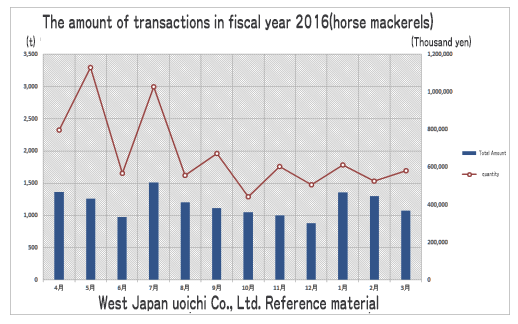
Matsuura city in Nagasaki prefecture is located in the northern part of Nagasaki prefecture near the prefecture border with Saga prefecture, wholesale company in Matsuura fish market is western Japan uoichi corporation, the transition of the amount of transactions of horse mackerels in year 2016 is the upper right graph . The red line shows that the 4 months from April to July shows the largest number of landings in the year, and by chance the year 2016 graph seems to have been unfished in June, but the year 2017 According to the halfway data, June seems to have been the second landing after June in July, and it is no doubt that June is also the season of the landing of horse mackerels in June.
Nagasaki prefecture sells coastal objects 'Gonaji' and offshore objects 'Tokiaji' nationwide as a Nagasaki brand, but there are other countries nationwide including Sekiaji (Oita), which is particularly famous as a brand horse mackerel, Setsukiaji ( Yamaguchi), Tenryoaji (Kumamoto), Bibiaji Miyazaki, and so on. Among them, "Donchichiaji" in Hamada-shi, Shimane Prefecture, is differentiating rivals with the character of Digitizing of the lipid content. The standard is japanese horse mackerel with a size of 50 g or more that was caught between April and August with the most fatty period, and using an exclusive device, the average of the lipid content exceeds 10% Only as "Donchichiaji" is certified.
Japanese horse mackere in season is not less than brand horse mackerel
I would like to appreciate that being sold as a brand horse mackerel with high quality horse mackerel that has reached its own standard like this in various parts of the country. But since japanese horse mackerel in the season from around April to July gets more fish especially in the year, prices are also good, so many fresh items are good and there are too much fat, so it's not brand horse mackerel It is a season when it becomes very delicious.
During this period especially beans horse mackerel (zengo) and small horse mackerel are also caught a lot, and horse mackerels of plenty are often sold at price superior cost performance, so attractive items like the following images It will be provided in various places.
| Beans horse mackerel and mall horse mackerel commercialized in season | |
|---|---|
 |
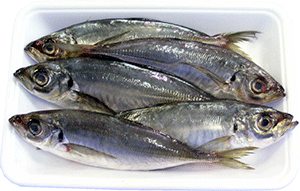 |
| Beans horse mackerel (zengo) | Small horse mackerel |
 |
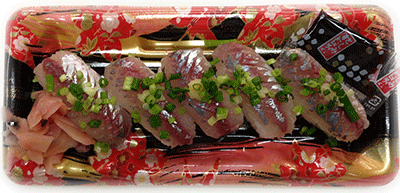 |
| Beans horse mackerel (zengo) segoshi sashimi | Small horse mackerel half body nigirisushi |
 |
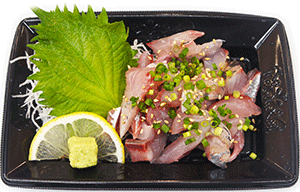 |
| Beans horse mackerel (zengo) small cut sashimi | Small horse mackerel small cut sashimi |
In the above image, I introduced products that eat raw japanese horse mackerel as sashimi and sushi which will increase in the spring to early summer season such as bean horse mackerel and small horse mackerel. In the field sense, it is a feeling that there is no other product with a high digestibility rate as much as the products of horse mackerels, and it seems that horse mackerels are proud of their strong popularity suited to Japanese tastes. In Japan, from horse horse mackerel called minimal zengo to huge Giant trevally, fish called horse mackerel who Japanese love is really sold as a variety of fish products, but after all it is fresh to eat raw It seems to be the most valuable to eat horse mackerel with sashimi and sushi.
For example, in the case of small horse mackerels, it is also effective to give customers the degree of freedom of cooking afterwards by selling them as half-length as in the image below, without increasing the added value by increasing the degree of processing to sashimi.
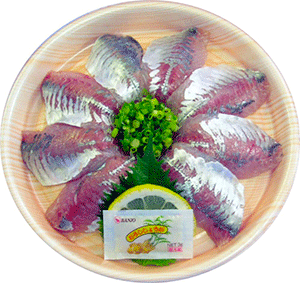 �@�@�@
�@�@�@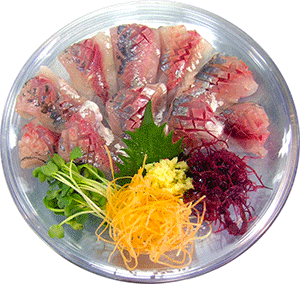
| Small horse mackerel halfbody for sashimi | Small horse mackerel halfbody for sashimi(kanoko) |
|---|
SKU commercialization of middle size horse mackerel
Let's talk about small horse mackerel, this time, next let's introduce the middle size horse mackerel in the form of product list.
| SKU commercialization of medium size horse mackerel | |
|---|---|
 |
 |
| Semi-headless with gills and the internal organs of the fish removed | Headless |
 |
 |
| two pieces disassembling | three pieces disassembling |
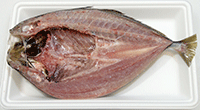 |
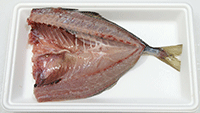 |
| Openfishbody with the head | �@Headless openfishbody |
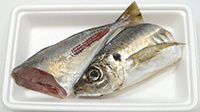 |
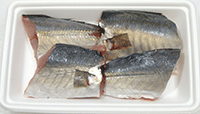 |
| Semi-headless to halve | two pieces disassembling to quarter |
 |
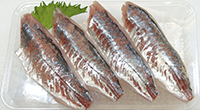 |
| halfbody with skin four pieces | halfbody no skin four pieces |
The middle horse mackerel is easy to use for various dishes, especially because it looks good in a tray when it is sashimi, it is easier to increase added value than large horse mackerel and small horse mackerel, actively to sashimi products I want you to use it.
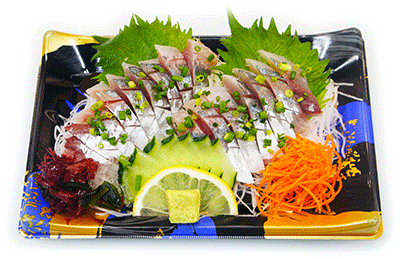
The middle horse mackerel sashimi
In addition, there is a figure sashimi as a method to increase the added value by making use of the size of the middle horse mackerel.
The figure sashimi of the middle horse mackerel
�@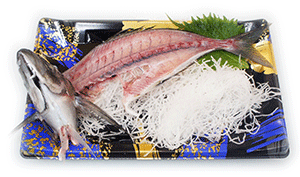 �@�@�@
�@�@�@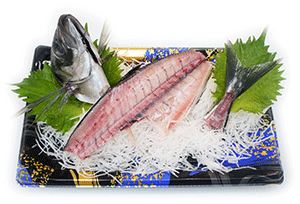
| The making of base of monolithic type | The making bese monolithic type |
|---|
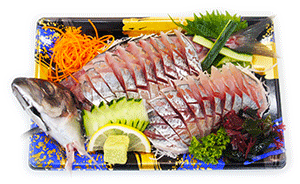 �@�@
�@�@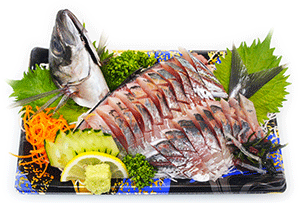
| monolithic type | separate type |
|---|
"namerou and sangayaki" covering the weak points of horse mackerel
I've been introducing figures and sashimi that can raise the value of the item to the highest level using japanese horse mackerel that you can get at a relatively inexpensive price so far, but the members of horse mackerel have in common One of the weaknesses is "discoloration is fast". Even if the freshness of horse mackerel is good or bad, it is common for blue fish such as mackerel and sardine that the body of horse mackerel, whose skin has been removed and exposed to air, changes color over time and darkens It is a disadvantage.
So let's explain below how to cover this weakness. According to a certain document, old fishermen seemed to have cooked horse mackerel on the boat with miso to cook and eat. This fisherman 's dish which was called "namerou" is so tasty that it was said that it got this name because he tried to "lick" the dish and ate it. And when the fisherman goes to work in the mountain, it brings in the abalone 's shell' surplus 'namerou' and brings it and burns it in a mountain cottage and seems to have been eating, not cooked on the ship, but cooked at the mountain house He called "sangayaki".
Let's show how to make "namerou" and "sangayaki" below.
| namerou and sangayaki | |
|---|---|
 |
 |
| 1, Cut off the chiai meat of fish of the halfbody of the horse mackerel from which the skin was removed. | 5, Cut small and add ginger. |
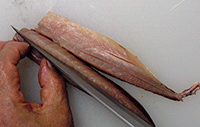 |
 |
| 2, Separate halfbody thinly vertically. | 6, Add more chopped green onion. |
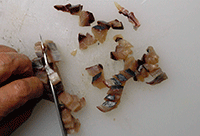 |
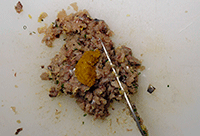 |
| 3, Turn thin and long cut meat sideways and cut it small. | 7, Add miso and mix. |
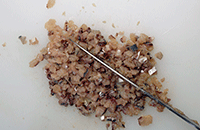 |
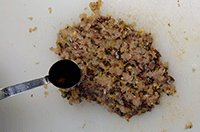 |
| 4, Cut a smaller piece of meat from the top with a kitchen knife strongly hit and cut it. | 8, finally add an appropriate amount of soy sauce and mix. |
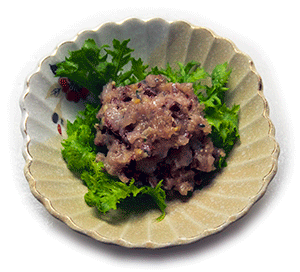 |
|
| horse mackerel namerou | |
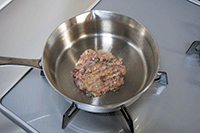 |
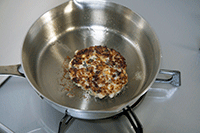 |
| 1, Put a bunch of namerou in a pot. | 3, Turn over when it turns on brown. |
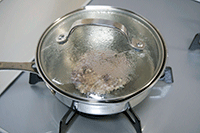 |
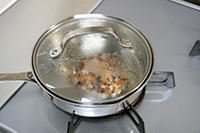 |
| 2, Smother while adding a little sake. | 4, Smother until the heat passes through the core. |
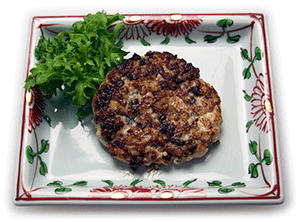 |
|
| horse mackerel sangayaki | |
I will end this month soon. When talking about Japanese food culture, horse mackerel is considered to be an indispensable important existence. Even the horse mackerel bone was discovered from the shell mounds of the Jomon Period, it has been proved that Japanese have eaten horse mackerel from long ago, and now as a handy fish dish, the frequency of appearing at dinner at home It can be said that it is one of the high fish.
The horse mackerel is a fish eaten by many Japanese cuisines from long ago and Japanese who have been prohibited by the influence of Buddhism to eat four legs animal meat until the Edo period have mainly fish animal I have ingested it as a protein source. As one of the fish, the horse mackerel of popular blue fish fish has been processed into dried fish and the like and has been eaten by the general public in large numbers. So I think that one drop of horse mackerel's blood is lurking in the blood of the Japanese.
The fish called horse mackerel will continue to be eaten with deeply involved in the Japanese dietary life, even though the resource is still going up and down, especially the japanese horse mackerel picked up this time is delicious among horse mackerels Because they are standing equal, it is no doubt that they will continue to be loved and loved by Japanese people. It can be said that it is a happy thing to be able to provide food customers rooted in such Japanese lives as fish sellers.
In this month's issue, I've got a lot of heartfelt feelings about how much I could describe the horse mackerel of great existence including the historical meaning. I think that I could express a little "hint of sales of japanese horse mackerel" as a description viewpoint.
From now on to June July, there will be a season when many delicious japanese horse mackerels are caught and price is also available and easy to sell. I would be happy if you would sell japanese horse mackerel with some reference to the items that readers posted in this issue.
An opinion and the communication are to iinfo@fish food times
Date of updating 1 Jun. 2018
